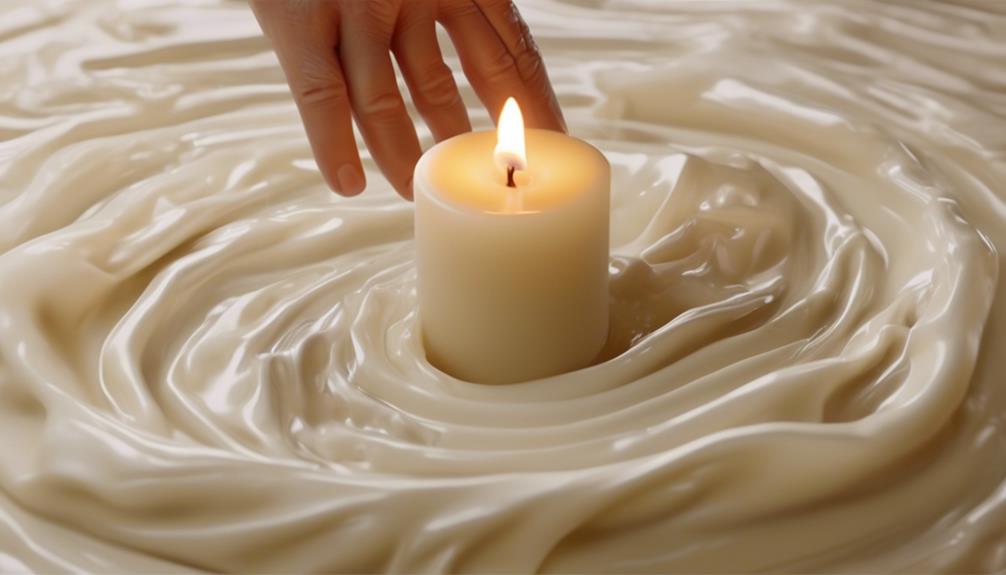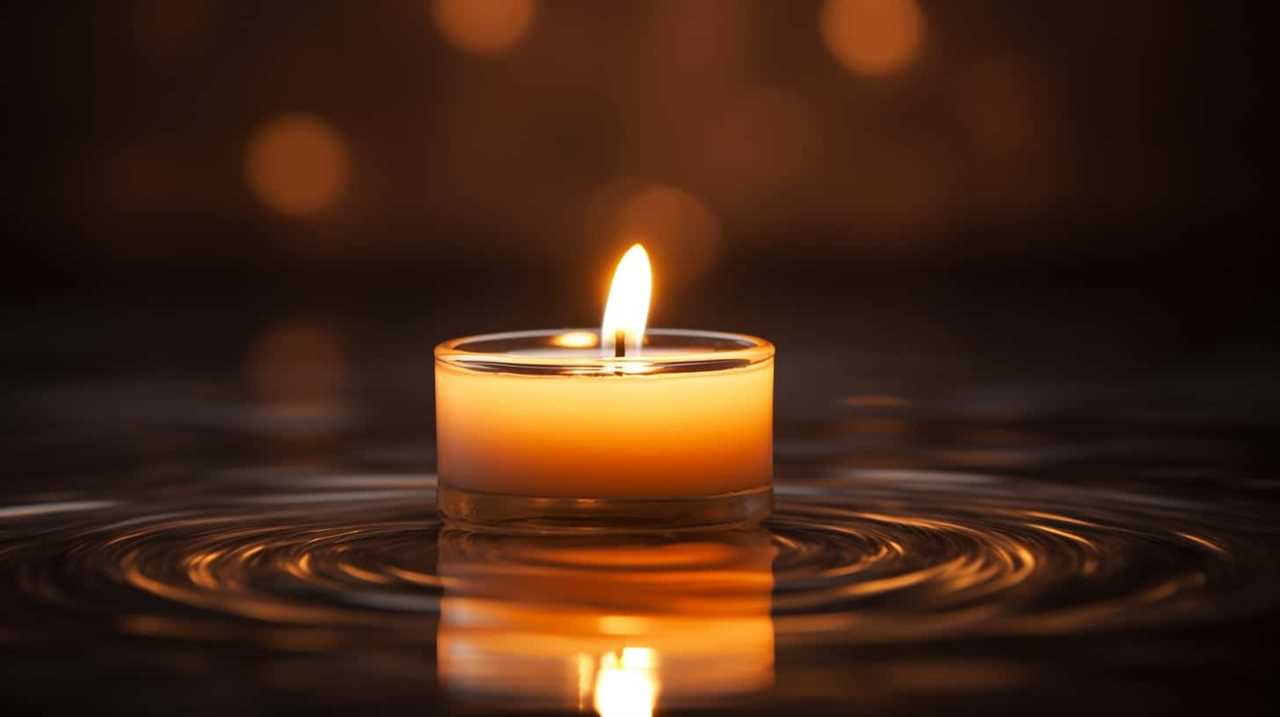Let’s delve into the bright language of candle wax and its mysterious messages. Interpreting the faint hints left by a melting candle can provide understanding of the hidden influences affecting our fates.
As we explore the intricate art of candle wax interpretation, we uncover a world where wax whispers secrets and shadows reveal stories.
Join us as we unravel the mysteries hidden within the flickering flames and delve into the captivating realm of candle wax symbolism.
Key Takeaways
- Wax flow direction reveals spell power and energy distribution.
- Curling wax suggests gradual fulfillment of desires or strong compliance with wishes.
- Shape patterns in solidified wax offer hidden insights and messages.
- Color variations in the wax reflect emotional or energetic aspects of the spell.
Basics of Candle Wax Reading
When beginning the practice of candle wax reading, it's crucial to select traditional candles that allow for the natural flow of wax, avoiding dripless varieties. The choice of candles significantly impacts the reading, as the wax needs to move freely to form distinct patterns and shapes. Dripless candles inhibit this natural flow, making it challenging to interpret the wax properly.
In candle wax reading, the direction of the wax flow is a fundamental aspect that carries valuable information about the spell's power. Observing whether the wax moves steadily downward or if it meanders in different directions can provide insights into the energies at play. Additionally, specific shapes formed by the solidifying wax, such as curling or flooding, offer significant clues. Curling wax may indicate ignorance of desires or a strong compliance with wishes, while wax flooding suggests a more substantial impact than initially anticipated.
Mastering the basics of candle wax reading requires attention to detail and a deep understanding of how different candle types and wax movements influence the interpretation process.
Assessing Candle Spell Wax
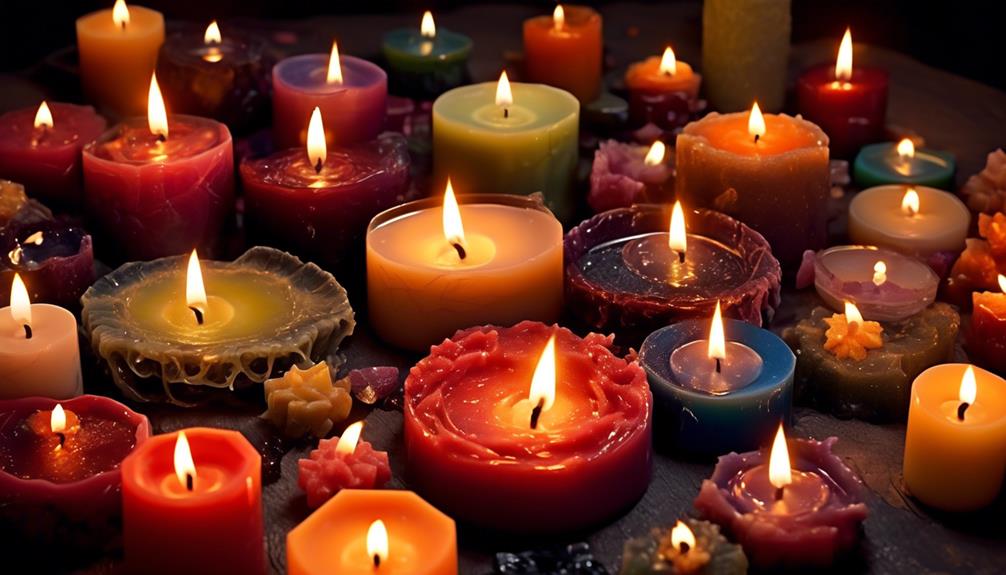
Assessing candle spell wax involves carefully observing the formations and movements of the wax throughout the spell's duration to extract valuable insights into the energy at work. When delving into the assessment of candle spell wax, here are four key considerations to keep in mind:
- Utilize drip candles: Opt for drip candles as they offer the most optimal wax formations for interpretation, providing a clearer understanding of the spell's progress.
- Continuous assessment: Regularly monitor the wax as the spell unfolds to gain a deeper understanding of how the energies are interacting and evolving over time.
- Interpret negative formations: Negative wax formations can signify the spell's efficacy in removing obstacles or dispelling negative energies, offering clues about the spell's impact.
- Final wax formations: Complete the spell to ensure an accurate reading of the wax, as the concluding wax formations often carry crucial messages about the spell's outcome and effects.
Review of Candle Wax Reading
In candle wax reading, a skilled practitioner deciphers the intricate shapes and patterns left behind by the melted wax to unveil hidden insights and messages. Reviewing candle wax reading involves a detailed analysis of various aspects such as Wax Flow, which can provide crucial information about the effectiveness of the spell or ritual performed. By observing the direction of the wax flow, practitioners can gain insights into the spell's power and energy distribution.
The following table outlines key elements to consider during the review of candle wax reading:
| Aspect | Significance |
|---|---|
| Wax Flow | Indicates spell power and energy distribution |
| Negative Formations | Suggest removal of obstacles or negative influences |
| Curling Wax | Signifies gradual fulfillment of desires |
| Shape Patterns | Unveil hidden insights and messages |
| Color Variations | Reflect emotional or energetic aspects |
Mastering the review of candle wax reading requires a keen eye for detail and a deep understanding of the symbolism present in the wax formations. By carefully analyzing these elements, practitioners can unravel the messages hidden within the melted wax.
Tips for Candle Wax Reading
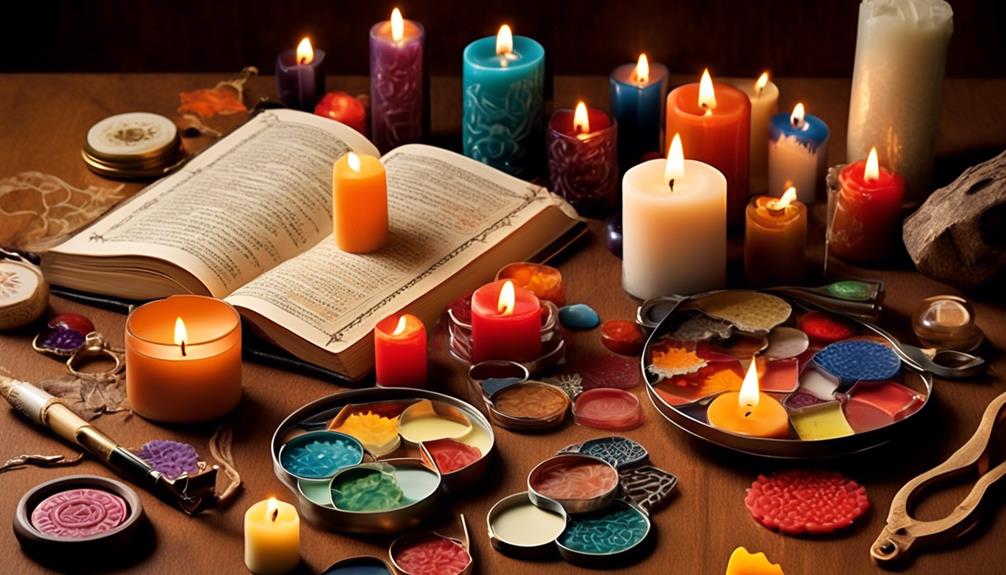
When examining candle wax, our experience has taught us to interpret colors and shapes carefully as they hold significant meaning. Consider residue patterns left behind, as they can offer valuable insights into the spell's impact.
Analyzing the burn duration provides crucial information about the energy and strength of the spell cast.
Interpret Colors and Shapes
Analyzing the colors and shapes present in candle wax can provide valuable insights into the messages and energies being conveyed during a reading.
Tips for Interpreting Colors and Shapes in Candle Wax:
- Color Significance: Different colors hold symbolic meanings; for example, white may represent purity or new beginnings, while black could signify protection or banishing negativity.
- Shapes and Forms: Pay attention to shapes formed by the wax; hearts may indicate love or relationships, while spirals could suggest personal growth or transformation.
- Flow Patterns: The direction of wax drippings can offer clues about the energy flow in a situation; wax flowing towards you might symbolize incoming energy or influence.
- Interpretation Techniques: Utilize scrying methods with water and natural materials to decipher intricate patterns and symbols within the melted wax.
Consider Residue Patterns
By observing the residue patterns left by the melted candle wax, valuable insights can be gleaned to enhance the depth of a candle wax reading experience. When examining the melted wax, consider residue patterns as they hold hidden secrets of the divination art. The way the wax flows can reveal much about the candle burns and the energy surrounding the situation. Take note of the variety of shapes formed by the remaining wax, as each shape may signify different meanings. Write down anything significant that catches your eye, as these details can provide crucial information for your interpretation. Delve into the intricacies of the melted candle to uncover the mysteries and messages it holds.
| Observations | Interpretations |
|---|---|
| Wax flow direction | Spell's power |
| Curling wax | Fulfillment of desires |
| Wax flooding | Intensified outcomes |
Analyze Burn Duration
To gain deeper insights into the effectiveness of a candle spell or intention, closely analyzing the duration of the burn is essential. When examining the burning candle, consider the following:
- Longer Burn Duration: A prolonged burn may indicate delays in manifestation or obstacles impeding progress.
- Shorter Burn Duration: A swift burn could suggest rapid effectiveness or easy realization of the intention.
- Flame and Wax Changes: Monitor any alterations in the flame or wax throughout the burning process for additional clues.
- Context and Intuition: Remember to factor in the broader context and trust your intuition when interpreting the burn duration of a candle.
Candle Wax Flow in Spells

When examining the flow of candle wax in spells, our focus is on interpreting the direction and patterns to gain deeper insights into the spell's potential outcomes. One crucial aspect to observe is the cascade flow of wax. This occurs when the melted wax cascades down the candle in a continuous stream, indicating a smooth and consistent manifestation of the spell's intentions. A steady and uninterrupted cascade flow suggests that the energy behind the spell is strong and stable, leading to a successful outcome.
In candle wax reading, the cascade flow can also represent a continuous flow of positive energy towards the target of the spell. It signifies a harmonious alignment between the spellcaster's intentions and the universe, ensuring that their desires are steadily being realized.
When analyzing the cascade flow, pay attention to any interruptions or irregularities in the stream, as these could indicate obstacles or challenges that need to be addressed in order to keep the spell's momentum going strong.
Clockwise Candle Wax Flow
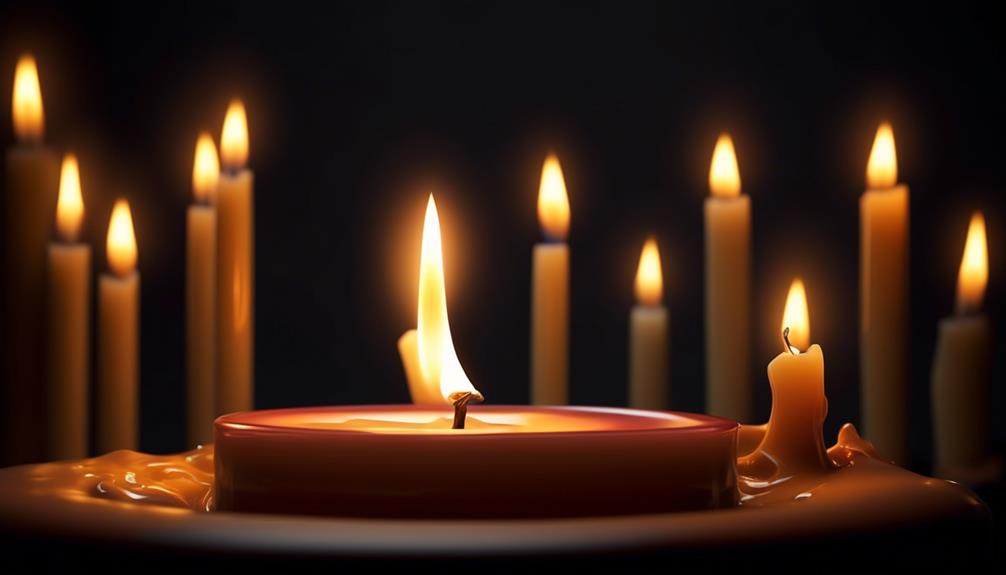
When analyzing the clockwise flow of candle wax, we discern a favorable outcome and the drawing of positive energies towards the intended goal. Understanding the significance of the flow direction is crucial in deciphering the message the spellwork conveys.
Interpret Clockwise Wax Movement
In observing candle wax during a spell, the clockwise movement signifies a favorable outcome and a drawing in of success and positive energies. When interpreting clockwise wax movement, we consider the following:
- Wax Dripping: The steady flow of wax in a clockwise direction indicates a smooth progression towards the desired goal.
- Flow Means: The fluid motion of the wax symbolizes the alignment of energies working in harmony to manifest intentions.
- Moving Away: Absence of wax moving away from the center suggests that obstacles are being overcome, and manifestations are coming closer.
- Interpret Clockwise Wax Movement: Understanding the clockwise wax movement is crucial for recognizing the manifestation of success and the attraction of positive energies in the spellwork.
Significance of Flow Direction
Flow direction in candle wax plays a crucial role in indicating the success and attraction levels within a spell. Specifically, clockwise movement signifies positive energy and the amplification of the spell's intended outcome. Observing the candle color, the small candle should be lit on a surface you don't mind scorching. As the candle burns, the wax will start to melt and flow. Be attentive to the side of the candle that burns first, as this can also provide insights into the spell's progression. Always consider the type of candle used and the environment in which you perform a candle wax reading.
Observing Wax Patterns
As we witness the clockwise flow of wax during a candle wax reading, the significance of success and attraction in the spell becomes illuminated, indicating positive outcomes and the fulfillment of desired goals. Understanding the intricate details of this wax pattern can provide valuable insights into the efficacy of your spellwork.
Here are four key points to consider:
- Clockwise flow denotes the spell working in your favor, bringing about success and attracting positive energies.
- It symbolizes the actualization of your desires and the achievement of your set objectives.
- Progress and advancement are suggested by the clockwise movement, indicating forward momentum in your magical endeavors.
- Analyze the direction and velocity of the wax flow for deeper revelations regarding the strength and impact of your spellcasting efforts.
Counterclockwise Wax Flow

Observing the rotation of candle wax as it solidifies can provide valuable insights into the environment and conditions in which the candle was burned. When the wax flows counterclockwise as it cools, it indicates a unique set of circumstances that can be deciphered through careful analysis. This phenomenon is not as common as clockwise wax flow and often requires a more nuanced interpretation.
| Factors | Interpretation | Possible Causes |
|---|---|---|
| Uneven Burning | The candle likely burned unevenly, causing the wax to flow in a counterclockwise direction. | Drafts, irregular wick trimming |
| Temperature Fluctuations | Rapid changes in temperature can affect how the wax solidifies, leading to counterclockwise flow. | Opening windows, air conditioning |
| Candle Placement | Placing the candle near a source of airflow or heat can influence the wax flow direction. | Proximity to fans, vents |
Cascade Flow of Wax Layers
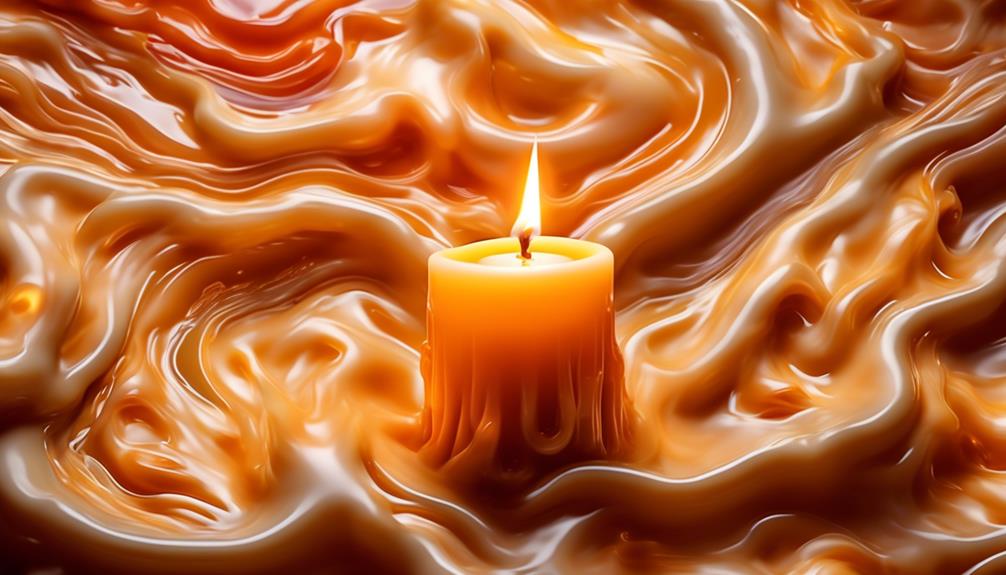
When analyzing the cascade flow of wax layers, we observe intricate wax layer patterns that hold valuable clues for interpretation.
By examining the thickness, shape, and direction of these layers, we can gain insight into the burning process and the energies at play.
Our experienced eye will discern subtle details, allowing us to unravel the story hidden within the cascading wax.
Wax Layer Patterns
Studying the cascade flow of wax layers in candle readings provides valuable insights into the energy dynamics and potential transformations surrounding the spell or intention.
- The cascade flow of wax layers refers to the formation of multiple layers of wax dripping down the side of the candle, often resembling a waterfall or a series of small steps.
- This pattern indicates a strong and powerful energy surrounding the spell or intention, suggesting significant changes or transformations.
- Pay attention to the direction and shape of the cascade flow as it can provide additional insights into the specific nature of the changes taking place.
- Understanding wax layer patterns can help practitioners navigate the complexities of the energies at play and make informed decisions regarding the spellwork or intention set forth.
Interpretation Techniques
In candle readings, discerning the cascade flow of wax layers serves as a key indicator of the potent energies and significant transformations influencing the spell or intention.
When observing the cascade flow, a downward movement indicates the gradual release and manifestation of energies, suggesting a steady progression towards the desired outcome.
Conversely, an upward flow signifies rising energies, potentially indicating a quick resolution or a sudden burst of change.
Understanding the direction and speed of this cascade flow is crucial in interpreting the intensity and timing of the spell's effects.
It's essential to pay close attention to the nuances of how the wax layers cascade, as each shift and movement unveils valuable insights into the unfolding energies at play.
Candle Wax Backflow
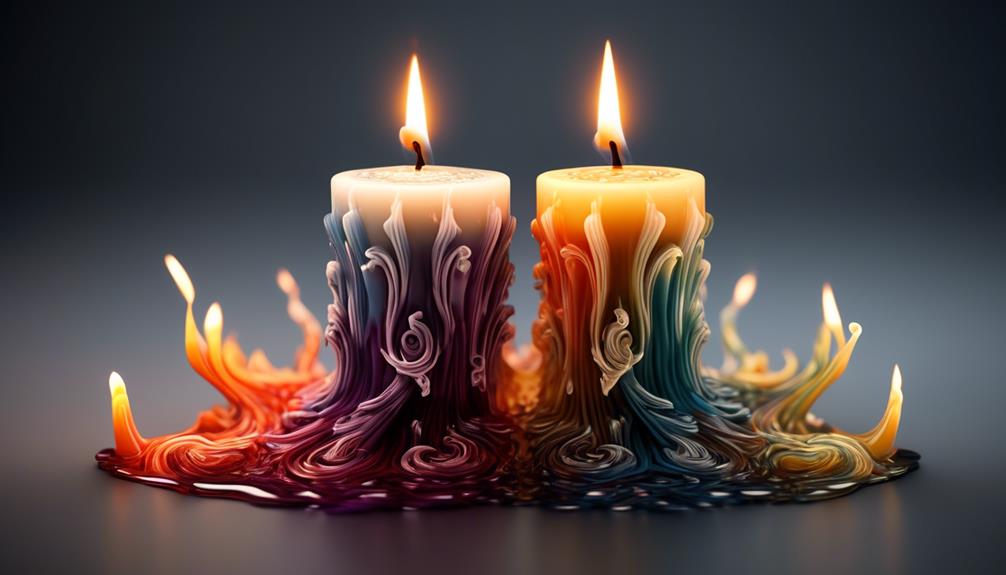
As we observe the phenomenon of candle wax backflow, it becomes evident that the temperature differentials play a crucial role in this intriguing process. This occurrence, often seen in container candles, happens when the wax liquefies but fails to burn completely, leading to a reverse flow of the melted wax. Understanding candle wax backflow requires a keen eye and knowledge of the factors at play.
- Temperature Control: Maintaining a consistent temperature in the environment where the candle burns is essential to prevent wax backflow.
- Candle Placement: The positioning of the candle in draft-free areas can help regulate the temperature around the flame, reducing the likelihood of backflow.
- Wick Selection: Opting for the correct wick size can influence how evenly the wax burns, potentially minimizing backflow.
- Candle Composition: Different types of wax behave uniquely, so choosing the appropriate wax for your candle can impact backflow tendencies.
Reading Curling Wax
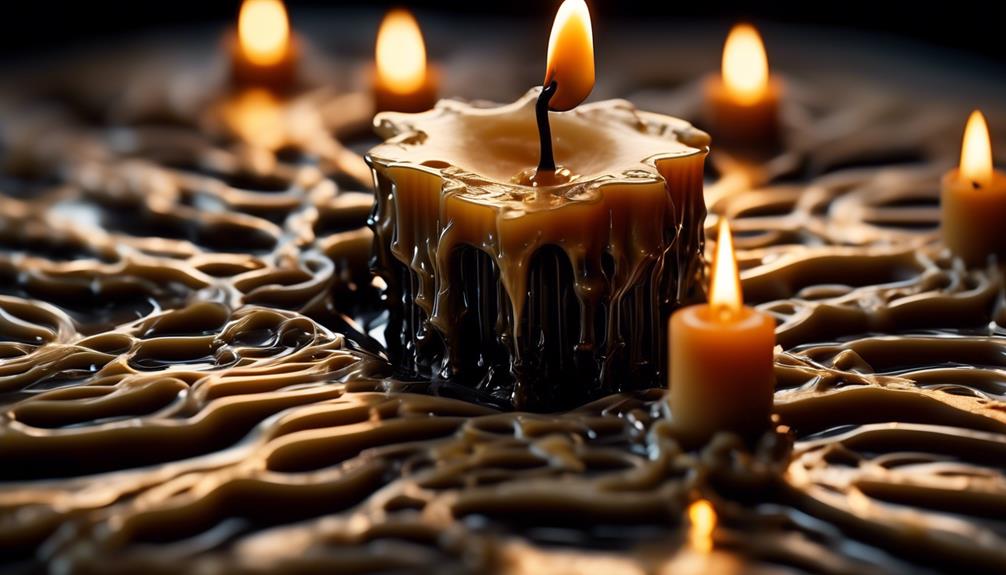
When interpreting the significance of curling wax patterns, attention must be paid to the intricate shapes and directional flow of the curls. Each curl tells a story, reflecting the bending of desires or the compliance with wishes.
Like petals on a flower or the gentle roll of an ocean wave, curling wax signifies the gradual fulfillment of desires. It can also indicate the act of overpowering another person, situation, or circumstance.
To master the art of reading curling wax, one must observe the nuances in the shapes and the subtle shifts in direction. A sharp eye for detail and a deep understanding of the symbolisms associated with curling patterns are essential.
Candle Wax Floodings
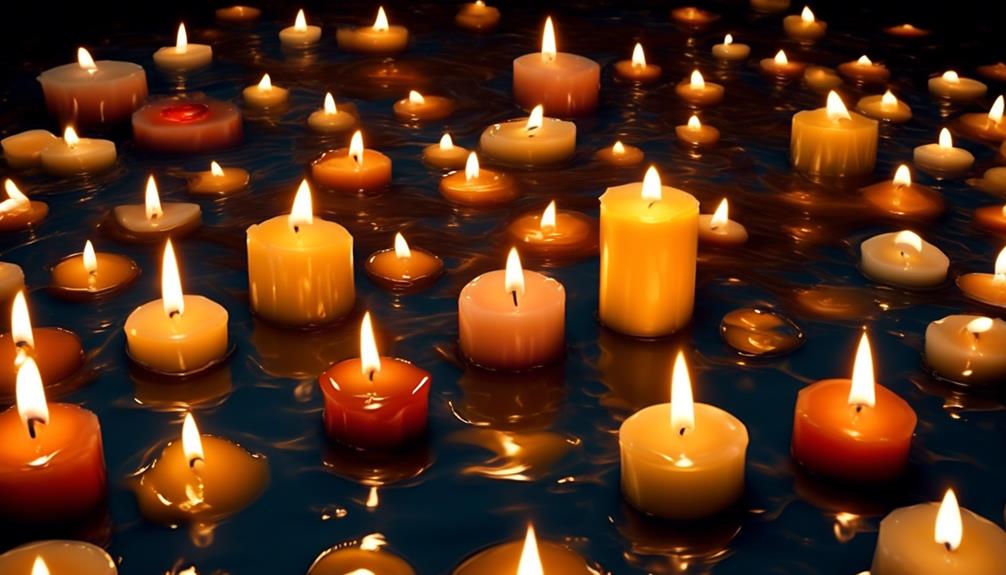
When dealing with candle wax floodings, it's crucial to observe the wax pooling patterns to understand the candle's behavior.
Identifying signs of wick drowning can help troubleshoot issues of uneven burning, ensuring a more effective candle spell.
Wax Pooling Patterns
Wax pooling patterns, also known as candle wax floodings, provide crucial insights into the deeper workings of a spell's impact and energy dynamics.
- Overwhelming Impact: When wax flooding patterns exceed expectations, they indicate a potent and overwhelming influence that may throw off your balance.
- Negative Formations: Negative wax patterns could suggest that the spell is actively removing obstacles in your path towards the desired outcome.
- Curling Wax: The slow curling of wax signifies a gradual bending of the spell's target, reflecting a gradual but steady fulfillment of desires.
- Direction of Flow: The direction of wax flow, whether clockwise, counterclockwise, cascade, or backflow, holds significant information about the spell's power, success, timing issues, and potential reversals.
Understanding these wax pooling patterns can deepen your comprehension of the spell's effects and guide your next steps towards mastery in candle reading.
Identifying Wick Drowning
If the candle flame struggles to consume the liquefied wax, creating a ring of molten wax around the wick, this phenomenon is known as wick drowning. When identifying wick drowning, look for a significant amount of melted wax pooled around the wick, hindering proper burning. This occurrence signifies potential issues with the candle's wick length or quality, which may require trimming or relighting for optimal performance. To further enhance your understanding, observe the colors and shapes formed by the melted wax, offering additional insights into the message being conveyed. Below is a table summarizing key points related to identifying wick drowning:
| Key Points | Description |
|---|---|
| Appearance | Ring of molten wax around the wick |
| Significance | Indicates improper burning and potential solutions |
| Observations | Wick length, quality, colors, shapes of melted wax |
| Implications | Candle care, emotional or energetic imbalance |
| Resolution Strategies | Trim wick, relight candle, adjust burning conditions |
Troubleshooting Uneven Burning
Have you ever encountered a candle that burns unevenly, causing wax to flood around the wick? When troubleshooting uneven burning, consider the following:
- Check for Drafts: Ensure the candle is placed in a draft-free area to promote even melting.
- Trim the Wick: Keep the wick trimmed to 1/4 inch to prevent soot buildup and ensure a clean burn.
- Use a Level Surface: Place the candle on a flat, stable surface to help the wax melt evenly.
- Consider Candle Snuffers: Extinguish the flame with a snuffer to prevent wax splatter and maintain even burning.
Interpreting Candle Wax Flood
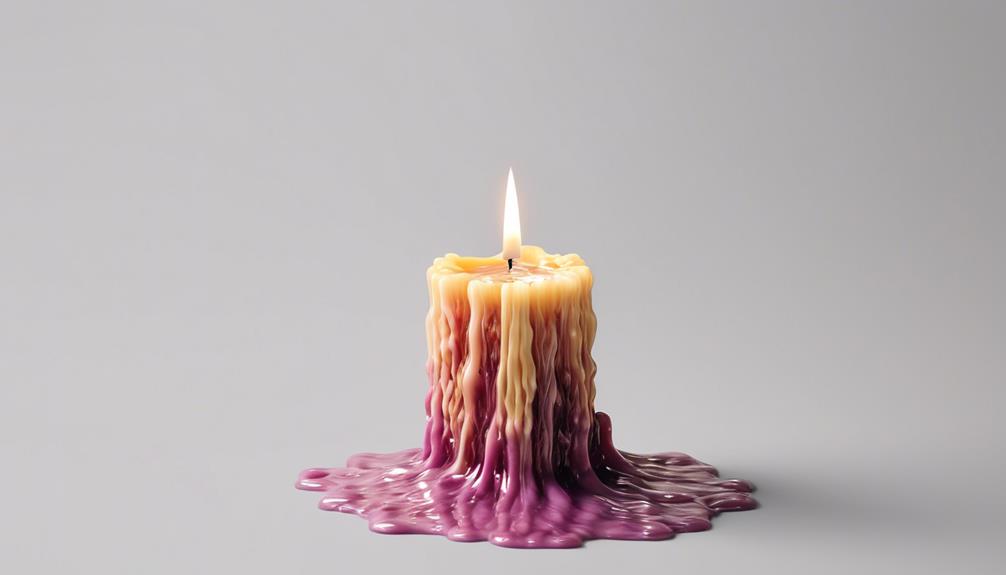
When interpreting a candle wax flood, the expansive spread of melted wax signifies a potent release of energy and a compelling manifestation of the spell's intention. The flood's uncontrolled nature hints at a surge of power unleashed by the spell, creating a strong impact on the situation at hand.
This sudden and intense outpouring of wax can indicate a rapid transformation or resolution brought about by the spell's energy. It's crucial to observe not only the spread of the wax but also the shapes and patterns it forms as they may offer additional insights into the spell's effects.
The intensity of the flood mirrors the depth of emotions or the magnitude of outcomes associated with the spell, providing a visual representation of the forces at work. By carefully analyzing the characteristics of the candle wax flood, practitioners can gain a deeper understanding of the spell's influence and the changes it catalyzes.
Candle Wax Reading for Partial Burn
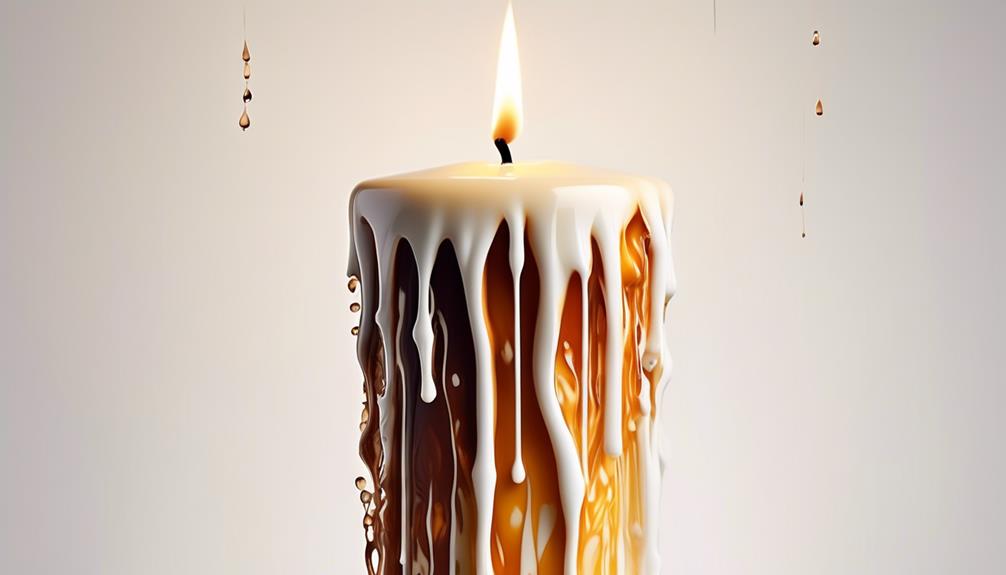
Upon observing the remaining wax post-partial candle burn, one must meticulously analyze any shapes, symbols, or patterns that have emerged to decipher their significance.
- Texture: Note the texture of the remaining wax. Is it smooth, rough, bubbly, or crystallized? Each texture may convey different messages about the energy surrounding you.
- Color: Pay attention to the color of the wax formations. Different colors hold various meanings in candle wax reading. For instance, white may symbolize purity or new beginnings, while black could signify protection or the need for inner reflection.
- Location: Consider where the wax formations are located in relation to the candle. Wax closer to the wick might indicate current influences or issues, whereas wax on the outer edges could represent future events or external factors.
- Interpretation: Trust your intuition and personal connection to interpret the meaning behind the wax formations. Your insights, combined with the observed details, can provide a holistic understanding of the message being conveyed.
Reasons for Partial Burn
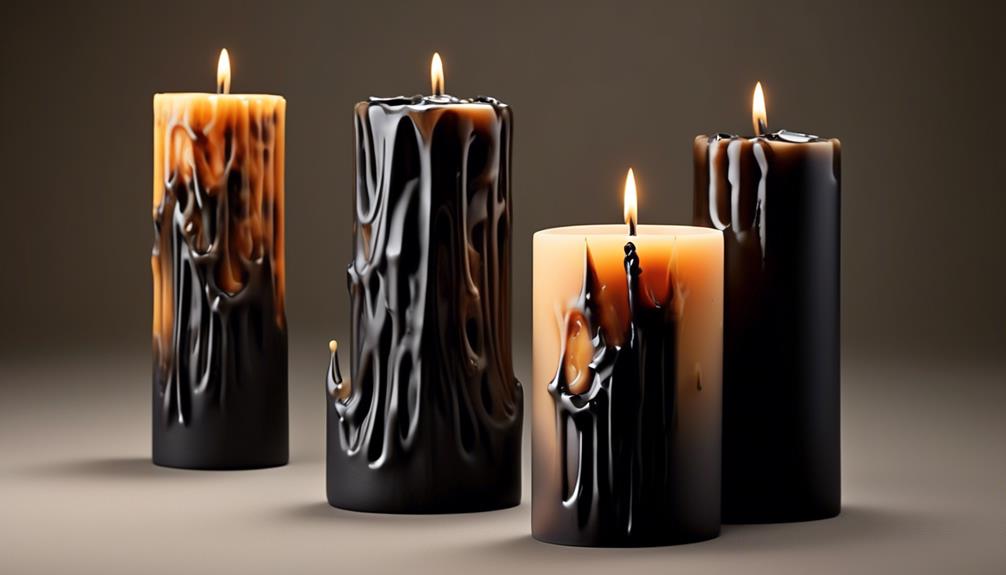
Analyzing the wax remnants after a partial burn provides insights into the reasons behind this occurrence, shedding light on the energies at play during the candle's use. When a candle burns partially, several factors could be influencing this outcome. Understanding these reasons can enhance your candle reading skills and interpretive abilities. Here are some common reasons for a partial burn:
| Reasons for Partial Burn | Explanation |
|---|---|
| Drafts | Air currents affecting the flame |
| Wax Pool Size | Insufficient pool for complete burn |
| Wick Length | Wick too short or trimmed incorrectly |
| Wax Quality | Lower quality wax affecting burn |
Scrying Steps for Candle Wax

After identifying the reasons for a partial burn in candle reading, practitioners can now apply scrying steps to interpret the formations in the candle wax.
- Prepare Your Space: Find a quiet and comfortable area to conduct your candle wax scrying. Ensure you have good lighting to observe the wax formations clearly.
- Focus Your Intentions: Before starting the scrying process, focus your mind on the specific question or intention you have for the reading. This will help guide the interpretation of the wax shapes.
- Observe and Analyze: As the candle burns and the wax drips, pay close attention to the patterns and symbols forming in the wax. Take note of any significant shapes or figures that catch your eye.
- Trust Your Intuition: Use your intuition to interpret the meanings behind the wax formations. Trust your inner guidance and feelings to uncover the messages being conveyed through the candle wax.
Frequently Asked Questions
How Do You Read Candle Lights?
When reading candle wax, we carefully observe the melted shapes and patterns formed. Each symbol carries a specific meaning, offering insights into the spell's power and intention.
The direction of the wax flow, whether it's clockwise or counterclockwise, holds significance. Curling wax suggests a gradual bending towards the spell's desired outcome, while wax flooding signals a potentially stronger impact than expected.
Interpreting these signs requires attention to detail and experience.
What Does Wax Symbolize Spiritually?
Wax symbolizes transformation and change in spiritual practices. Its flow direction indicates the energy and power of intentions. Curling wax signifies gradual fulfillment of desires and bending circumstances.
When wax floods, it suggests greater impact than expected. The shapes formed by the wax offer insights from the spiritual realm. It's essential to interpret these signs with a trained eye to grasp the messages being conveyed by the candle wax.
How Do You Read a Candle in Water?
When we read a candle in water, we look for subtle clues in the way the wax disperses. By carefully observing the direction and speed of the wax flow, we can uncover hidden meanings. This technique requires patience and keen observation skills.
It's like deciphering a secret message written in nature's own language. Mastering this art can reveal profound insights and unlock a deeper connection to the universe.
What Does a High Flame Mean?
When we see a high flame while working with candles, it typically signifies passion, intense emotions, or a surge of energy. This powerful flame indicates that the spell or intention is being fueled with great strength and efficiency.
However, it's crucial to exercise caution with a high flame, as it may also suggest a need for moderation or control. To gain a full understanding, always observe any other signs or symbols present alongside the high flame.
Conclusion
As we gaze at the intricate patterns left behind by the melted wax, we're reminded of the depth and complexity of the universe. Each shape, symbol, and direction holds a message waiting to be deciphered.
The art of candle wax reading is a powerful tool for tapping into the unseen energies that surround us, offering insights and guidance for those who are open to receiving them.
Dive deep into the wax, and let the secrets it holds reveal themselves to you.

